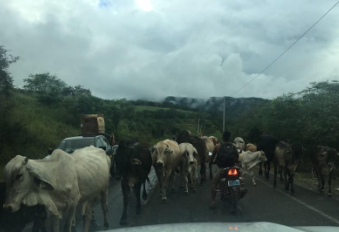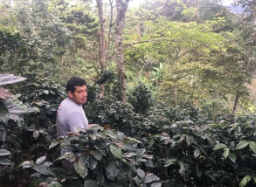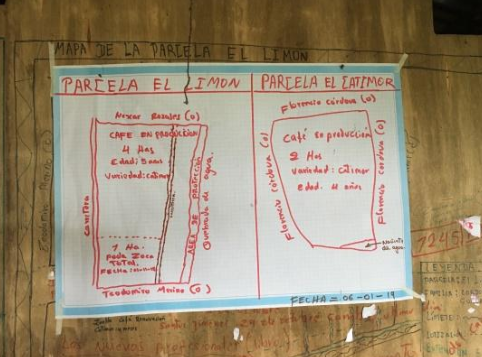Now we are heading to the second farm. It takes about 45 minutes’ drive plus 20 minutes walking. I cannot complain as the view was insane!
Field trip - Day 1 by Catalina
Current Juncture
Peru is facing continuously corruption scandals. The latest one was the suddenly death of the former president Alan Garcia who was under investigation because of the Odebrecht case. Prosecutors said they believed Mr. Garcia received more than US 100.000 from this company, as payment for winning lucrative contacts in the Peruvian region. After the accusations the former president didn’t stand the pressure and shot himself.
Garcia would have been the third former president in Peru to have been jailed in the Odebrecht case. Ollanta Humala spent nine months in pre-trial detention in 2017-2018 and Pedro Pablo Kuczynski was arrested without charges.
However despite all these scandals, the economy in Peru grew by 4%, the inflation has been controlled and ranging between 1% and 3%, fiscal debt is on a downtrend and overall the exports increased. The best performances came from services, manufacture, and agricultural activities. However there was still a lack of important structural social reforms to improve the life conditions of their 32 MM people.
Coffee context
Peru produced 4.37 million bags of coffee in 2018, up from 4.12 in 2017, but still down from the pre Roya crop of 4.5 million in 2011. Today there is a growing area of 400.000 ha (still below the 495.000 ha before roya), and the national productivity average is 11.8 bags per ha.
However due the low market prices the yearly incomes of the producers decreased by 5.5%. This is raising some concerns in the sector as some producers are deciding to substitute their plantations by cocoa, citrics, kion, and even more worrying coca. In the last 5 years, according to the JNC, about 5.000 ha have become coca plantations. To put it on perspective: growing coffee generates on daily basis an average of 30/40 soles (US 10.5) while coca pays about 100 soles (US 30).
In 2019 is expected that between 10.000 and 15.000 ha will stop producing coffee because of these new substitutes products. However, the JNC is working together with Minagri to invest about US 365 MM in renewing coffee plantations, promoting internal consumption (It’s at 200.000 bags) and associative models.
Besides the difficult situation, the crop in 2019 is expected to be at same levels than previous year or even 1% higher, and this mainly to better yields, and productivity.
Journey
It has been 4 days through the Northern part of Peru, which concentrates 60% of the coffee production: Cajamarca and San Martin, close to the border with Ecuador.
Day 1 : Cenfro Cafe
Elmer Peña (Commercial Manager Cenfrocafe), Sergio Puentes (Production Manager Cenfrocafe) and Duduer (our driver) picked me up at the hotel in Jaen. We started our Journey towards San Ignacio, one of the most important growing areas of Cajamarca Region. Elmer and Sergio talked about their background in coffee, and those two together represents 30 years in coffee.
Elmer pretty much joined Cenfro from the very beginning since 2004 and still with them, while Sergio has been with Cenfro for 9 years. Before, he was working with other Cooperatives and private coffee companies in Peru, and also spent some years in Brazil.
Cenfro is the largest cooperative in Peru. They work directly with group of producers, more of 3.300 farmers, whom are associated in 120 groups in each surrounding area. Each group is managed by the board of directors formed by 5 people (president, manager, and delegates) who are responsible of representing them in the General Assembly of the Cooperative.
These groups are divided by districts, called “redes”, 11 in total, depending on the area. They have assigned 1 agronomist responsible of giving all the technical support from the Cooperative. Also when gathering some groups in redes, it helps to bring all the expertise from the area to learn from each other and to create a strong community feeling around coffee.

Cows jam
While waiting, in the “cows jam”, Elmer tells me that they have quite a problem with the age of the farmers as there are not young generations stepping into the farming activities. They prefer to go to the cities and working in something different rather than staying at the field.
This is becoming quite a problem and they have one project where the ambition is to attract the young generations to stay at the field, by teaching them how to administrate in a better way a farm to get better incomes, by increasing productivity.
To become a member of Cenfrocafe is not as easy as it used to be. They are evaluating more carefully the potential candidates and it can take up to 2 years to be accepted. They are very strict with the minimum requirements the producer has to meet, especially if planning to be part of the sustainable segment where the Cooperative makes quite an investment.
All their sustainable producers are Fairtrade certified, the registration at the first time is at producers cost, but then maintaining them within the program is subsidized by the Cooperative thanks to the Social Premium.
When it comes to Organic, it’s a little bit different, the producer has to be very sure and show willingness to be part of this program, as they are the ones to cover all the costs of the certification, and renewals. This higher cost will be compensated with better incomes specially when selling fairtrade and organic.
About Cenfro Cafe
Cenfro did last year 260.000 QQ and they expect 2019 to be even better @300.000 QQ. With the new plant built in Jaen end of 2018, they are in conditions to meet this target. Of the total volume 50% was sold as sustainable (35% FTO, 5% FT, followed by RFA and some UTZ) and 50% as conventional.
There is still quite some potential to do much more sustainable coffees as 80% of their producers are certified. All of them are FLO, and some others are Organic, RFA and UTZ.
Cenfro has 6 collection points in Cajamarca and San Martin region. Most of the producers are located in altitudes above 1400 masl. The average productivity of the producers is 19 bags per ha (above the national one). The average size of their farmers is 3.25 ha. Cost of production is around 120 cts FOB equivalent.

La Naranja
Family: Garcia Campos
Altitude: 1650 masl
Asociation: Café del Bosque
Zone: Los Lirios
Ricardo Garcia
After talking for 2 hours, we have arrived to the first farm in La Vereda La Balsa. Beautiful landscapes around, with lot of mountains.
I met with Ricardo, the owner of the farm. He is a father of 3 sons, plus his wife. He is the president of the Association Café del Bosque conformed by 38 members. He has in total 3 ha, and it’s producing about 23 bags per ha. At his farm he has caturras and Bourbon trees, and thanks to such varieties he is producing coffees scoring 87 points!
Ricardo starts harvesting in May until October. The trees are 5 years old and looking in good conditions. He has about 5000 trees per ha and fertilize two times using non chemical products. The cost of production of his farm is estimated at US 66.5 per QQ parchment. The previous crop he made about USD 3000 as profit. On top of this, he also grows passion fruit, but still coffee is their main income.
His farm is certified organic and fairtrade. Thanks to the social Premium he has received good technical support from Cenfro such as: crop management and subsidies of planting material. The Association is working with Cenfro since 2002.
All the wet process is done at farm level. He has good water controls where the water is filtered after using it to wash the coffees, at the point that can be even consumed.
Ricardo was a very curious guy, he wanted to understand what happens after the coffee leaves Peru, so we had a good talk about our role (Supremo). Also we talked about the glyphosate risk and he showed me the products he uses to fertilize their farms (Guano de Isla) which are not containing any banned product. He is conscious about the importance of good farming practices as he doesn’t want to put in risk the incomes for his family. His older son, also bought 2 ha of coffee and he helps him to maintain it.
Before leaving the farm, I got to see some other things they grow at their farms, such as pigs, chickens, and to my surprise guinea pigs! This last one is a traditional dish in Peru, but to my fortune I didn’t have to eat it ☺
Farm 2: Parcela el Limon and Catimor
Now we are heading to the second farm, the president of the Organization Flora and Fauna. It takes about 45 minutes’ drive plus 20 minutes walking. I cannot complain as the view was insane!

Family: Cordoba
Altitude: 1600 masl
Asociation: Flora and Fauna
Bernabe Cordoba
I met with Bernabe Cordoba, a man of 41 years old. He inherited a hectare from his mom long time ago and by then he harvested 8 QQ. He decided to cut the trees because the plants were quite tired, and after 2 years the new production reached 45 QQ per ha. Since 10 years he is been farming in a very technical way and he has bought more hectares with the profit made with coffee.
Berna (how the people call him) has his wife and two more kids. The older one is studying agronomy and the young one is still going to the school. He actually walks every day 45 minutes per journey to get to his classes in the small village.
Berna is the president of the Association Flora and Fauna conformed by 49 producers (7 women and 42 men). Apparently is one of the Associations with more women in this area!

Variety Catimor
At the farm, the variety is catimor, and it produces 32 bags per ha. Since last year, Berna is implementing selective pickings where just red cherries are being collected. He pays 1 sol (US 0.30) more the pickers per lata. The normal cost is 5 soles (US 1.5) but with this practice they get US 1.8. During the main season the pickers can fill between 10 to 15 latas per day.

Berna is working with Cenfro since 2004, and he is certified as organic and fairtrade. The organic certification got it already since 10 years ago. One of his main focuses at the farm is the soil. I have not met any producer more conscious about it before! He truly believes that if the soil is in great condition and properly taken care of, there will be less use of fertilizers, and long lives to agricultural products. I cannot be in more agreement with him. Hence when I asked about the glyphosate he just told me that he would never use something that could kill him or his family.
The cost of production of his farm is 350 soles (US 106) per QQ parchment, of which 40% is recollection, 30% supplies, and 30% maintaining the trees. In a year Berna makes about 10.000 soles (US 3000) profit.
After finishing this great meeting with Berna, it is time to have lunch! We go to San Ignacio and I get a very nice Aji de Gallina with some fried bananas. While eating we keep talking about the different challenges the farmers have to meet certain standards. Sergio tells me that for organic the most current non conformities are: delimitating the parcels with fences, controlling the sewage waters, controlling the compox of cherries and keeping the registers of the administration of the farm.
Cenfro is in constant vigilance of the Associations and the promoters (56) working for their agronomists (7) are visiting the redes constantly. This is one of their main investments at Cenfro.
At the end of the lunch I asked for a cup of coffee, but to my surprise none of them ask for one. Sergio tells me that the consumption internally is very poor just around 550 gr per capita a year.
Finca Cruz del Chalpon
We keep our journey to the last visit of the day, the farm of Cenfrocafe (Finca Cruz del Chalpon) where they are testing 28 varieties. I’m very excited to see how this is looking like. We continue driving for about 40 minutes and finally we arrive. We are received by Albertino Meza, he is the agronomist engineer responsible of the farm.
We start with the tour around the 10 ha farm. I feel like jumping from one country to the other as they have 28 varieties and still pending to get 5 more. This project is in coordination with the World of Coffee from whom Cenfro got some financing to make this happen. The idea is to evaluate the productivity of the different varieties and their reaction to the weather, altitudes, etc.
Some of the varieties are: Lempira, EC16, H1, Oro Azteca, Bourbon, Geishas, Colombia, Mondo Novo, Typica, Catimor, SLN 6, Batian, and guess what: Marsellesa (property of ECOM)
Bioazul provides the seedlings of Marsellesa, and it seems that is one of the best in terms of productivity. They are even considering negotiating with ECOM more of these trees to sell it to their farmers.
It looks like Catimor is a good variety for lower altitudes, Marsellesa for medium altitudes, and Caturras and Geishas for higher altitudes. Still it is premature to say it because the project is rather “new”.
Training
At this farm they are training their members for better farming practices, making examples of how to plant a tree, what kind of supply to use, how to have their own nursery beds, etc.
It was a technical visit, but happy to see the investment they are making for offering properly technical services to their group of farmers. When selling seeds, Cenfro finances 50% of the cost.
a warehouse in San Ignacio
After having a complete tour to the farm I thanks Albertino and his son, that was actually following us during all our mini tour. The young man is getting ready to take over from his father at some point ;) Btw he is a Barcelona fan.
We go back to the car, and now heading to San Ignacio to see quickly one of their collection points. I was expecting a modest warehouse, but when arrived there I saw a big facility with capacity to store up to 40.000 QQ! They built it 4 years ago, and bought 3 driers to receive wet parchment from their farmers.
At this facility most of the coffee from the area is received and then transported to Jaen. They have a lab there to control the quality and also treasury office to make the payment to the producer after getting analyzed the deliveries.
After this visit we go back to Jaen. During this time, Elmer explains me how they manage the social premium of the producers. Most of this is managed by Cenfro and it’s decided every year on the General Assembly how to be invested. The main focus so far has been the increase of productivity and technical support to the farmers. Also they use it to improve the quality.
After the campaign is finished and depending on the sales of Fairtrade coffees, they recognize a premium to the producers that it’s normally given between Feb and March (like a bonus)
Also we talk about women in coffee, and to my surprise the percentage of women in Cenfro is just 9%. If we have interest, these 300 women could produce about 12 containers of FTO coffee.
